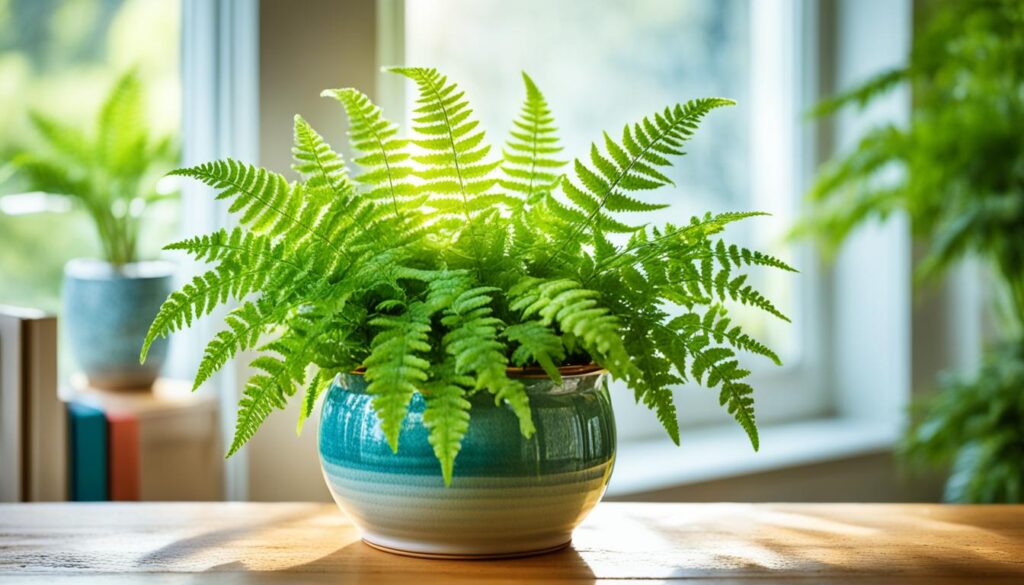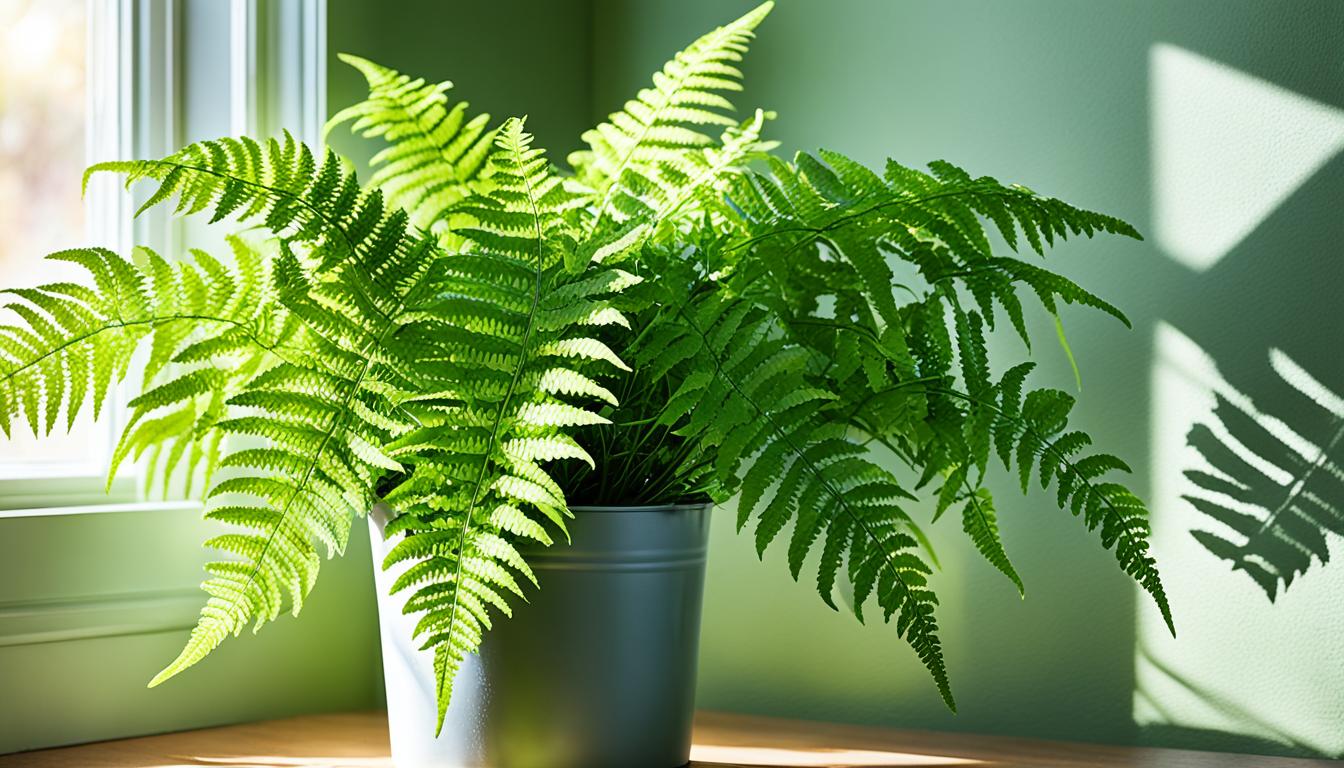Want to make your living space look lush and green? Indoor ferns are the perfect choice. They’re easy to care for and can make any room look beautiful. But, you might wonder how to keep them healthy indoors. This guide will show you how to grow and care for indoor ferns.
Indoor ferns are great for adding natural beauty to your home. But, they need the right care to thrive. You’ll need to think about light, humidity, watering, and pruning. With the right care, you can have a beautiful indoor fern garden that everyone will love.
Understanding the Basics of Indoor Fern Care
Ferns are great houseplants, adding lush greenery and texture to any room. They can thrive indoors if you meet their care needs. The history of ferns as houseplants goes back to the Victorian era, when they became very popular in Europe.
Why Grow Ferns Indoors?
There are many reasons to grow ferns indoors. They clean the air by removing toxins, making the air healthier. Their beautiful leaves also add natural beauty to any room, creating a calm atmosphere. Plus, they’re easy to care for, perfect for busy people or beginners in gardening.
The Victorians and the Fern Craze
The Victorians loved collecting and showing off ferns, leading to a “fern craze” in the 19th century. They kept ferns in special greenhouses called Wardian cases. This era helped make growing ferns indoors a popular tradition that continues today.
Ferns were the must-have plant of the Victorian era, with enthusiasts scavenging the countryside for new and interesting specimens to add to their collections.
The Victorians’ love for ferns changed indoor gardening and influenced home and public space designs. Ferns became a sign of elegance and a connection to nature. Today, their charm still attracts gardeners, keeping the Victorian fern craze alive.
Light Requirements for Indoor Ferns
Understanding the light needs of indoor ferns is key to their care. These plants do well in bright, indirect light. They should stay away from direct sunlight to avoid damage to their delicate fronds.
Indirect Light is Best
A north- or east-facing window is perfect for indirect light for indoor ferns. This type of light is soft and diffused, ideal for ferns. If there’s little natural light, adding a grow light for a few hours daily can help.
Avoiding Direct Sunlight
Too much direct sunlight can turn fern fronds yellow and dry them out. Direct sun is too harsh for these plants, causing stress and decline. Keep your ferns away from south- or west-facing windows to avoid direct sunlight. This way, you meet their fern light needs effectively.
“Ferns have very specific light requirements when grown indoors, and understanding these needs is crucial for their health and longevity.”
Temperature and Humidity Needs
Creating the perfect home for your indoor ferns is key to their health and life span. The right temperature and humidity levels are crucial for these plants to flourish at home.
Ideal Temperature Range
Ferns love a warm, cozy spot. They do best in a daytime temperature between 65°F and 75°F. At night, it’s okay to let the temperature drop to about 55°F.
Big temperature changes, like cold drafts or being near heat, can hurt your ferns. Try to keep the temperature steady for them.
Maintaining High Humidity Levels
Along with the ideal temperature for indoor ferns, they need high humidity levels. Regular misting or a humidifier can keep them moist. Putting your ferns close together also helps keep the air around them humid.
If you have a bright bathroom, the steam from your showers can be great for your ferns. Just make sure they’re not too close to the heat from the shower.
“The key to happy, healthy indoor ferns is recreating their natural, humid habitat as closely as possible.”
How to Care for Indoor Ferns
Keeping indoor ferns healthy takes a bit of effort. When watering them, make sure the soil stays moist but not too wet. Check the soil every week and water when the top inch feels dry. This way, you avoid letting the soil dry out too much.
During the growing season, ferns need a little food. Use a balanced liquid fertilizer at half strength to give them a boost. As they grow, you might need to move them into a bigger pot every few years. Make sure the new pot has good drainage to prevent root rot.
| Watering | Fertilizing | Repotting |
|---|---|---|
| Check soil weekly and water when top inch is dry | Use balanced liquid fertilizer at half strength during growing season | Repot every few years as plant grows |
By following these easy steps, you can help your indoor ferns flourish. They’ll keep your home looking lush and green.

“Ferns are the perfect addition to any indoor oasis, bringing a touch of nature and a calming ambiance to your home.”
Soil and Container Considerations
Choosing the right soil and container is key for your indoor ferns. Pick a soil mix that drains well and is light, with lots of organic stuff like peat moss or leaf mold. Adding sand or perlite helps with drainage, which is vital for ferns.
Ferns have shallow roots, so they do best in short, wide containers. Both plastic and clay pots are good choices, but plastic ones need watering less often. When your ferns get too big or root-bound, move them to bigger pots every few years to let them keep growing.
| Fern Soil Requirements | Choosing Pots for Indoor Ferns |
|---|---|
|
|
By focusing on the fern soil requirements and choosing pots for indoor ferns, you can make the best home for your ferns. This will help them grow lush and vibrant.
“The secret to growing healthy indoor ferns is in the soil and container choice.”
Popular Indoor Fern Varieties
There are many beautiful and tough ferns you can grow indoors. The Caterpillar Fern and the Rabbit’s Foot Fern are two great choices.
Caterpillar Fern
The Caterpillar Fern, also known as the Blue Star Fern, is a standout plant. Its blue-tinged rhizomes look like a caterpillar’s body. This fern is easy to care for and can handle some neglect, perfect for beginners.
Rabbit’s Foot Fern
The Rabbit’s Foot Fern is another favorite. It’s named for its furry rhizomes that look like a rabbit’s paws. Its lacy fronds add elegance and softness to any room. Like the Caterpillar Fern, it’s tough and can do well in less-than-ideal conditions, great for busy people.
There are many other indoor ferns you can grow, like the Bird’s Nest Fern and the Japanese Holly Fern. Each one has its own unique look, letting you create a beautiful indoor plant display.

“Ferns are the perfect way to add a touch of lush, natural beauty to any indoor space. With the right care, they can thrive and bring a sense of peace and tranquility to your home.”
Pruning and Propagation
Keeping your indoor ferns looking great means you need to prune them regularly. Cut off any dead or damaged fronds at the base with clean, sharp scissors. This helps your ferns focus on growing new, healthy fronds.
Pruning is key to propagating indoor ferns too. You can easily make more plants by dividing them or by using their spores. The easiest way is to split the plant’s rhizomes. This lets you make new ferns from the original one.
- Look for dead, damaged, or discolored fronds and cut them off at the base.
- Check the plant’s rhizomes for spots where you can split it into sections.
- Put the sections in well-draining potting mix, water well, and give them bright, indirect light.
- Collect and plant spores as your fern type requires, watching for new growth.
With the right care, your indoor ferns can live for many years. They add a lush, green touch to any room. Learning how to prune and propagate your ferns will help them stay healthy and beautiful.
| Pruning Tips | Propagation Methods |
|---|---|
|
|
Conclusion
Understanding the needs of indoor ferns helps you create a lush indoor oasis. You can choose from beginner-friendly or more challenging species. This guide provides tips to help your ferns thrive.
With proper care, indoor ferns can brighten your home for many years. Caring for these plants is rewarding, bringing the outdoors inside. By meeting their needs, you’ll enjoy their beautiful foliage and growth.
The secret to successful fern care is knowing their unique needs. Pay attention to their light, temperature, humidity, watering, and soil. With patience and care, your ferns will add elegance to your home.
FAQ
What are the light requirements for growing indoor ferns?
Ferns love bright, indirect light but avoid direct sunlight. It can burn their delicate leaves. A north- or east-facing window is perfect for them. If there’s little natural light, a grow light for a few hours a day can help.
What are the temperature and humidity requirements for indoor ferns?
Ferns do best in a warm, humid place. Daytime temperatures should be between 65°F and 75°F. At night, it should be about 10°F cooler, around 55°F.
Keeping the humidity high is key. Mist the leaves often or use a humidifier to help.
How should I water and fertilize my indoor ferns?
Keep the soil moist but not soaked. Check it every week and water when the top inch is dry. Don’t let it dry out completely between waterings.
Feed them a balanced liquid fertilizer during the growing season. Use it at half strength.
What type of soil and containers are best for indoor ferns?
Choose a soil mix that drains well and is light. Add organic stuff like peat moss or leaf mold. For better drainage, mix in coarse sand or perlite.
Ferns have shallow roots, so use short, wide containers. Both plastic and clay pots work well. Plastic pots need less watering.
What are some popular and easy-to-grow indoor fern varieties?
The Caterpillar Fern and the Lacy Rabbit’s Foot Fern are great choices. They’re easy to care for and can handle some neglect. They’re perfect for beginners.
How do I prune and propagate my indoor ferns?
Pruning keeps ferns looking great. Cut off dead or damaged fronds at the base with scissors. Many ferns can be split or grown from spores.
Dividing the plant is the easiest way to make new ones from the original.



